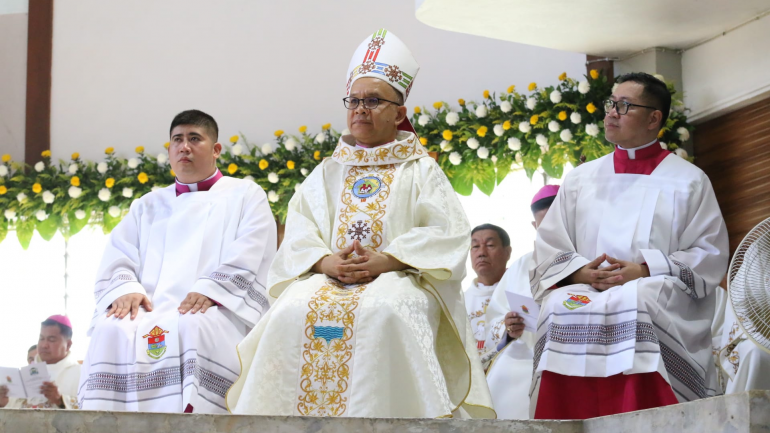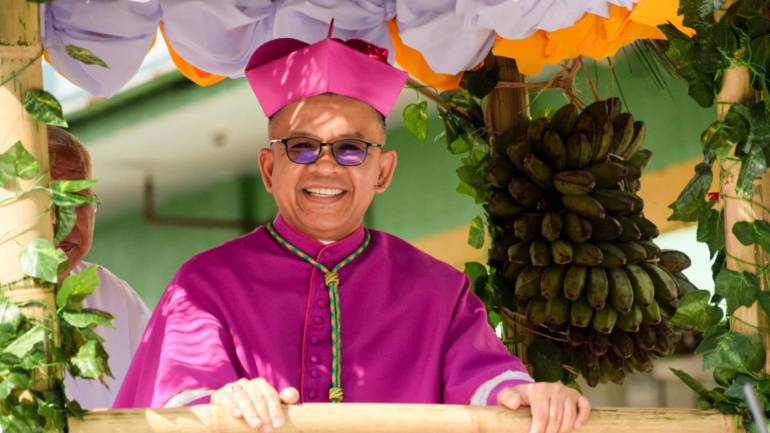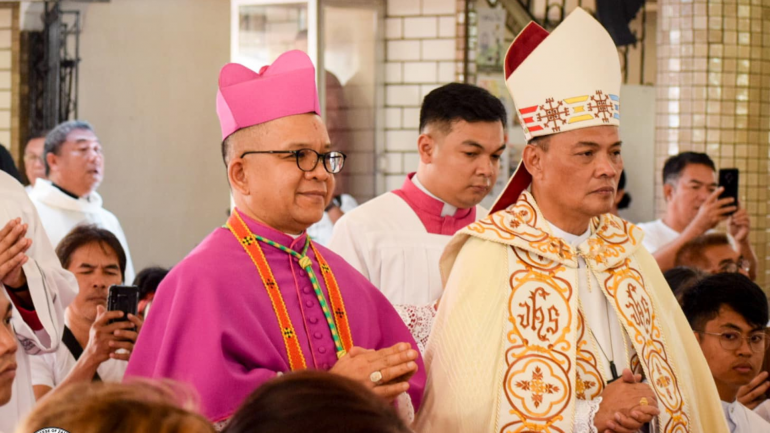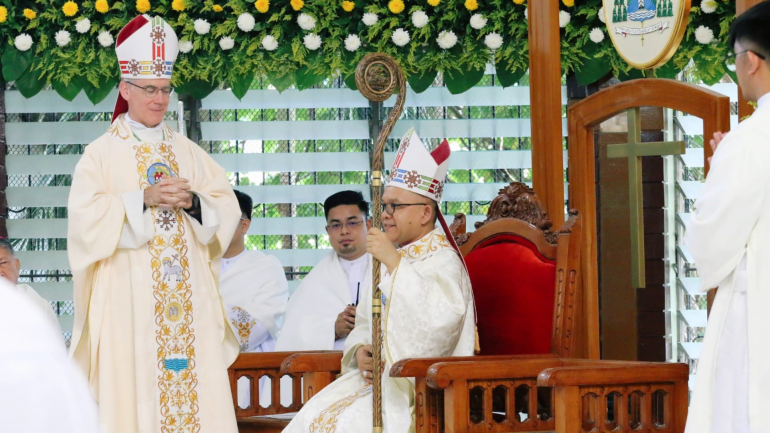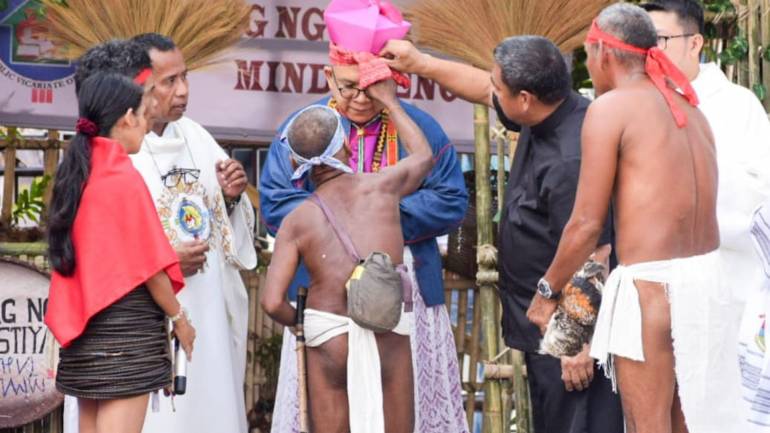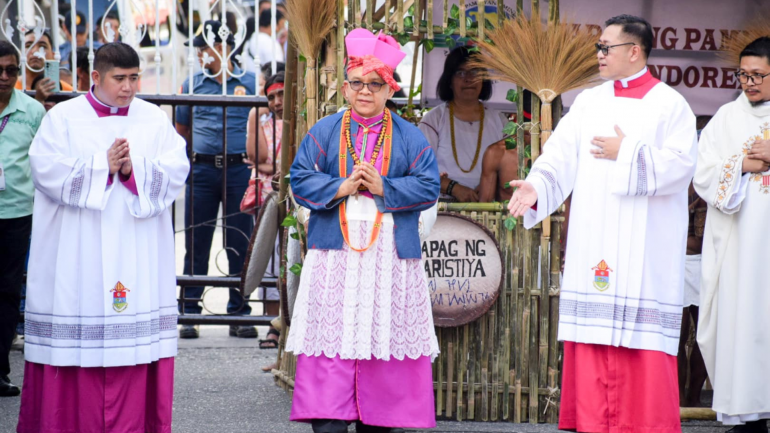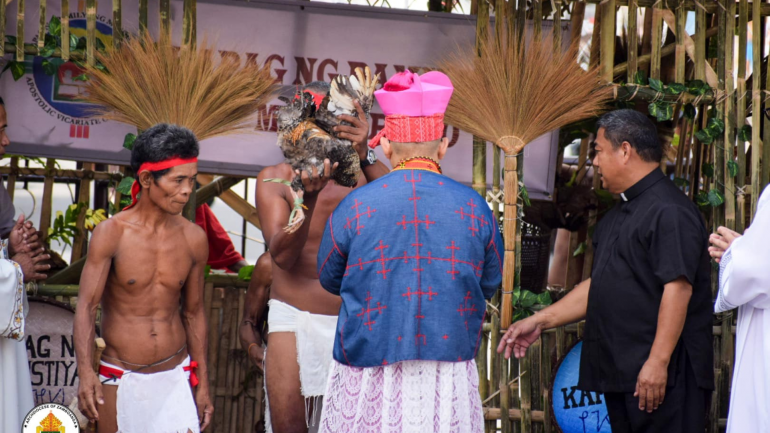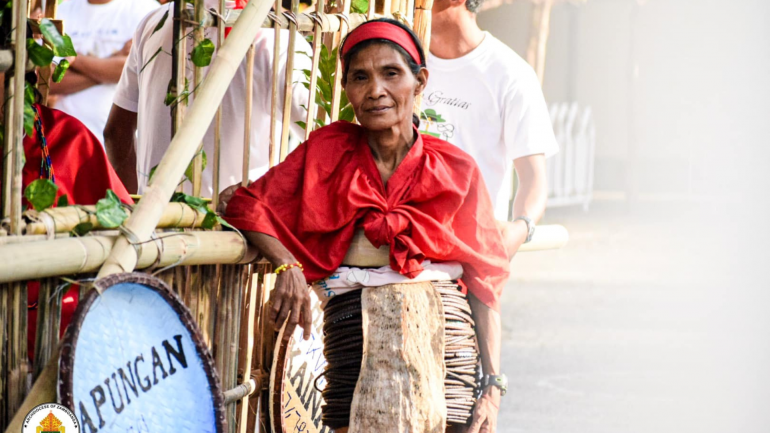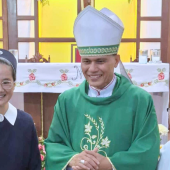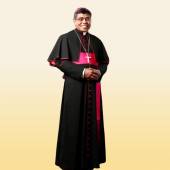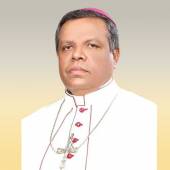Synodal bishop installed in Philippines missionary island
"Everything belongs, everything is for the Lord, everyone is involved; everywhere is for the mission. This is our synodal Church, the Church walking together," said Bishop Moises Magpantay Cuevas during his installation as bishop.
Dubbed the "synodal bishop for the synodal local church" in the Apostolic Vicariate of Calapan (AVC), his installation on September 6 at the Santo Nino Cathedral in Calapan City was considered "historic" and "blessed."
Pope Francis emphasized synodality in the last two years to mean a church that listens and walks with the people, especially those in the peripheries.
With Archbishop Charles John Brown, the Apostolic Nuncio to the Philippines, as the prelate, the cathedral was at full capacity, with around a thousand people in attendance, including around 30 bishops and 100 priests from across the country.
Bishop Mylo Hubert C. Vergara of Pasig, a vice president of the Catholic Bishops' Conference of the Philippines (CBCP), and Bishop Socrates Villegas, a former CBCP president, were both present.
"Cuevas is deemed the fourth Apostolic Vicar of Calapan", said Father Vicente R. Uy, JCD, judicial vicar and concurrent chair of the Episcopal Transition Team.
"Reckoned from the establishment of Mindoro Island as Apostolic Vicariate of Calapan in 1951, being an Apostolic Prefecture from 1936 to 1951, the first three Apostolic Vicars were William Josef Duschak, SVD (1951–1973), Simeon O. Valerio, SVD (1973–1988), and Warlito I. Cajandig (1989–2022)", Father Uy explained.
Five years ago, on September 1, Cajandig had a brain stroke. In November 2022, the Vatican announced that the Holy Father had "liberated" Cajandig from his office for health reasons.
Among his legacies are the vicariate’s core program, Hapag ng Pamilyang Mindoreno which emphasizes the family, the formation of the vicariate into nine vicar foranes, including the Mangyan Mission, and his social advocacies for the environment and good governance.
The 79-year-old Cajandig was only 45 when he was ordained and installed bishop. He served for 29 years until his being impeded. A memorial hall, which used to be a badminton court and a stock room at the bishop’s residence, was named after Cajandig, which apostolic administrator Fr. Nestor J. Adalia worked on very hard.
"Quite bizarre that we lost Bishop Cajandig on September 2, 2018, and Bishop Cuevas was given to us a new shepherd beginning September 4, and indeed on the month of Mama Mary, whose feast of nativity will be on September 8, and both of them have great devotions to the Blessed Mother, the latter to Our Lady of the Pillar. This, I believe, is no accident," said Fr. Uy.
Fr. Uy appealed to "continue praying for Bishop Cajandig, who is now in a vegetative state or post-coma unresponsiveness in his home province of Iloilo, while the vicariate takes charge of his needs then and now."
Under this predicament of an impeded and vacant see, since November 2018, the vicariate has been administered by Fr. Adalia, with the fatherly guidance of Archbishop Gilbert A. Garcera, Metropolitan of Lipa, Calapan, being its suffragan, who was able to ordain 10 priests for the vicariate.
Tribal welcome of the synodal bishop to the cathedral
Student dancers from Holy Infant Academy (HIA) welcomed the new bishop during a live broadcast by TV Maria and a live stream that received more than 100,000 views.
The first Apostolic Prefect Bishop-turned-Martyr William Finnemann, SVD, founded HIA in 1937 under the direction of the SSpS Sisters, making it the first and oldest Catholic school. The student dancers performed the karakol religious dance of the titular patron, Santo Niño, said Father Uy.
Father Uy stated that 30 Mangyans dressed in native attire who represented the seven Mangyan ethnolinguistic groups—the Hanunuo, Alangan, Iraya, Tadyawan, Buhid, Bangon, and Tau-build—welcomed Cuevas in a temporary bahay-kubo, a type of stilt house native to the Philippines, in the iconic Bayanihan Mangyan culture.
Father Gabayno Oybad, the first Mangyan priest, vested the new bishop with Mangyan attire, and then the Alangan Mangyans performed an indigenous welcoming ritual—payapyap and bangi—as part of inculturation, which is the adaptation of Christian teachings and practices to cultures," said Father Uy.
The Santo Nino Cathedral, which is the episcopal or bishop’s seat of the AVC, was founded in 1679 by an Augustinian Recollect, Father Diego de la Madre de Dios. It was fortified with stone walls due to frequent Moro raids on the island, according to the AVC on its social media page.
In August 1881, the church was burned and reconstructed in 1887. In 1960, a fire partially damaged it. Rufino Cardinal Santos, the Manila Archbishop, dedicated the current structure on July 15, 1962.
It was marked as a historical structure by the Philippine National Commission for Culture and the Arts. The cathedral is also the home of the highest and second-largest mechanical pipe organ in the country.
Installation rites made simple
"Our welcome ritual is a complete departure from the common and traditional civic reception conferred on the new bishop prior to installation mass. What we want to stress is that at the onset, this should be a purely ecclesiastical event, and so we want to portray the fusion of Hapag ng Pamilyang Mindoreno and Synodal Church," said Father Uy.
Cuevas, the youngest prelate in the country now at 49, solemnly walked on the red carpet with the Knights of Columbus as honor guards en route to the door of the cathedral, where he knocked three times and kneeled down.
At the door, Archbishop Garcera welcomed him and presented him for acceptance by Father Nestor J. Adalia, the apostolic administrator of Calapan, and the cathedral rector. The kissing of the crucifix and sprinkling of holy water by the new bishop ensued.
Then the Mass entrance procession of bishops followed. After the greeting, the Nuncio instructed that the Apostolic Letter—the appointment letter of the Pope in its original Latin manuscript—be read.
"Cuevas had personally shown the apostolic letter to the nine-member College of Consultors. Then Father Adalia read it in its Tagalog translation, and people acclaimed, Blessed be the Lord!" said Father Uy.
"Tagalog was used in lieu of Latin or English cognizant of one of the diverse insights from among diverse groups of people of God during the synodal consultation process at the diocesan level: ‘ang mahirap sa Simbahan kaya hindi maunawaan ng mga tao ang turo ay dahil sa pa-ingles-ingles pa’ and we take it to heart as a valid observation. That’s why even the rite of the Mass was in Tagalog", said Father Uy.
After the acclamation of the people and words of acceptance of his appointment, Cuevas was seated by the Papal Nuncio on the cathedra, or bishop’s chair, where he received a crosier (a hooked staff).
"At around 9:30 a.m., simultaneous ringing of bells in 40 pastoral areas beckoned the official assumption of Cuevas as the new chief shepherd of Oriental Mindoro, with over 750,000 Catholics scattered across 40 pastoral areas in the vicariate," said Father Uy.
Cuevas then proceeded to the foot of the sanctuary to receive the "synodal representations" from across 20 sectors.
"Again, this departs from the ‘conventional elitist’ form of homage insofar as this moment symbolizes the richness of a synodal church, which the new bishop wants to forge into a more synodal inclusive church going forth to everyone without exception to the poor and the sick, those who are usually despised and overlooked," said Father Uy.
Cuevas chose to have his coat-of-arms embellished with his episcopal motto "Virga Tua Consolatio Mea" (Your rod consoles me) to represent his trust in God with shepherding imagery attributed to Psalm 23:4: "Even though I walk through the valley of the shadow of death, I will fear no evil, for you are with me; your rod and your staff, they console me".
From Min-danao to Min-doro
Cuevas was born in Cuenca, Batangas, on November 25 and moved to the city of Zamboanga, where he entered the Pastor Bonus Seminary for philosophical studies and the Regional Major Seminary in Davao City for theological studies.
He was ordained priest for the Archdiocese of Zamboanga in 2000, at the age of 27.
In 2020, Pope Francis appointed him auxiliary bishop of Zamboanga and, in 2021, an apostolic administrator sede plena of the same archdiocese until the installation of its new archbishop, Julius Tonel of Ipil, as the new Zamboanga archbishop on August 22.
On June 29, he was appointed as Apostolic Vicar of Calapan. Madonna T. Virola
Radio Veritas Asia (RVA), a media platform of the Catholic Church, aims to share Christ. RVA started in 1969 as a continental Catholic radio station to serve Asian countries in their respective local language, thus earning the tag “the Voice of Asian Christianity.” Responding to the emerging context, RVA embraced media platforms to connect with the global Asian audience via its 21 language websites and various social media platforms.





